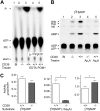Metabolism of circulating ADP in the bloodstream is mediated via integrated actions of soluble adenylate kinase-1 and NTPDase1/CD39 activities
- PMID: 22637533
- PMCID: PMC3425827
- DOI: 10.1096/fj.12-205658
Metabolism of circulating ADP in the bloodstream is mediated via integrated actions of soluble adenylate kinase-1 and NTPDase1/CD39 activities
Abstract
Extracellular ATP and ADP trigger inflammatory, vasodilatatory, and prothrombotic signaling events in the vasculature, and their turnover is governed by networks of membrane-associated enzymes. The contribution of soluble activities to intravascular nucleotide homeostasis remains controversial. By using thin-layer chromatographic assays, we revealed transphosphorylation of [γ-(32)P]ATP and AMP by human and murine sera, which was progressively inhibited by specific adenylate kinase (AK) inhibitor Ap(5)A. This phosphotransfer reaction was diminished markedly in serum from knockout mice lacking the major AK isoform, AK1, and in human serum immunodepleted of AK1. We also showed that ∼75% ADP in cell-free serum is metabolized via reversible AK1 reaction 2ADP ↔ ATP + AMP. The generated ATP and AMP are then metabolized through the coupled nucleotide pyrophosphatase/phosphodiesterase and 5'-nucleotidase/CD73 reactions, respectively. Constitutive presence of another nucleotide-converting enzyme, nucleoside triphosphate diphosphohydrolase-1 (NTPDase1, known as CD39), was ascertained by the relative deficiency of serum from CD39-null mice to dephosphorylate [(3)H]ADP and [γ-(32)P]ATP, and also by diminished [(3)H]ADP hydrolysis by human serum pretreated with NTPDase1 inhibitors, POM-1 and ARL-67156. In summary, we have identified hitherto unrecognized soluble forms of AK1 and NTPDase1/CD39 that contribute in the active cycling between the principal platelet-recruiting agent ADP and other circulating nucleotides.
Figures






Similar articles
-
Role of extracellular ATP metabolism in regulation of platelet reactivity.J Lab Clin Med. 2002 Sep;140(3):166-75. doi: 10.1067/mlc.2002.126719. J Lab Clin Med. 2002. PMID: 12271274
-
Intravascular ADP and soluble nucleotidases contribute to acute prothrombotic state during vigorous exercise in humans.J Physiol. 2007 Mar 1;579(Pt 2):553-64. doi: 10.1113/jphysiol.2006.119453. Epub 2007 Jan 4. J Physiol. 2007. PMID: 17204504 Free PMC article.
-
Characterization of circulating microparticle-associated CD39 family ecto-nucleotidases in human plasma.Purinergic Signal. 2014 Dec;10(4):611-8. doi: 10.1007/s11302-014-9423-6. Epub 2014 Aug 28. Purinergic Signal. 2014. PMID: 25165006 Free PMC article.
-
Thrombo-Inflammation: A Focus on NTPDase1/CD39.Cells. 2021 Aug 27;10(9):2223. doi: 10.3390/cells10092223. Cells. 2021. PMID: 34571872 Free PMC article. Review.
-
Metabolic control of excessive extracellular nucleotide accumulation by CD39/ecto-nucleotidase-1: implications for ischemic vascular diseases.J Pharmacol Exp Ther. 2003 Apr;305(1):9-16. doi: 10.1124/jpet.102.043729. J Pharmacol Exp Ther. 2003. PMID: 12649347 Review.
Cited by
-
Beneficial Role of Erythrocyte Adenosine A2B Receptor-Mediated AMP-Activated Protein Kinase Activation in High-Altitude Hypoxia.Circulation. 2016 Aug 2;134(5):405-21. doi: 10.1161/CIRCULATIONAHA.116.021311. Circulation. 2016. PMID: 27482003 Free PMC article.
-
Nucleotide ecto-enzyme metabolic pattern and spatial distribution in calcific aortic valve disease; its relation to pathological changes and clinical presentation.Clin Res Cardiol. 2020 Feb;109(2):137-160. doi: 10.1007/s00392-019-01495-x. Epub 2019 May 29. Clin Res Cardiol. 2020. PMID: 31144065 Free PMC article.
-
Anti-CD73 in cancer immunotherapy: awakening new opportunities.Trends Cancer. 2016 Feb 1;2(2):95-109. doi: 10.1016/j.trecan.2016.01.003. Trends Cancer. 2016. PMID: 27014745 Free PMC article.
-
Inflammatory biomarkers after an exercise intervention in childhood acute lymphoblastic leukemia survivors.EJHaem. 2022 Sep 29;3(4):1188-1200. doi: 10.1002/jha2.588. eCollection 2022 Nov. EJHaem. 2022. PMID: 36467791 Free PMC article.
-
The Role of Cluster of Differentiation 39 (CD39) and Purinergic Signaling Pathway in Viral Infections.Pathogens. 2023 Feb 8;12(2):279. doi: 10.3390/pathogens12020279. Pathogens. 2023. PMID: 36839551 Free PMC article. Review.
References
-
- Ralevic V., Burnstock G. (1998) Receptors for purines and pyrimidines. Pharmacol. Rev. 50, 413–492 - PubMed
-
- Marcus A. J., Broekman M. J., Drosopoulos J. H., Islam N., Pinsky D. J., Sesti C., Levi R. (2003) Metabolic control of excessive extracellular nucleotide accumulation by CD39/ecto-nucleotidase-1: implications for ischemic vascular diseases. J. Pharmacol. Exp. Ther. 305, 9–16 - PubMed
-
- Mercier N., Kiviniemi T. O., Saraste A., Miiluniemi M., Silvola J., Jalkanen S., Yegutkin G. G. (2012) Impaired ATP-induced coronary blood flow and diminished aortic NTPDase activity precede lesion formation in apolipoprotein E-deficient mice. Am. J. Pathol. 180, 419–428 - PubMed
-
- Yegutkin G. G. (2008) Nucleotide- and nucleoside-converting ectoenzymes: important modulators of purinergic signalling cascade. Biochim. Biophys. Acta 1783, 673–694 - PubMed
Publication types
MeSH terms
Substances
LinkOut - more resources
Full Text Sources
Other Literature Sources
Molecular Biology Databases
Research Materials
Miscellaneous

